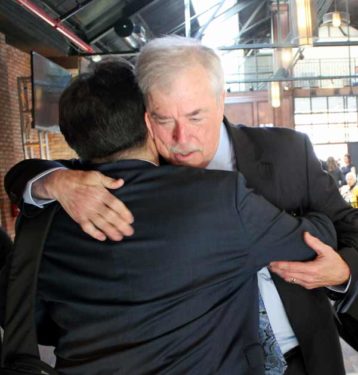By Jorge I. Domínguez-López
If you are a baseball fan, at some point you have to wonder how Babe Dahlgren felt on May 2, 1939 in Detroit right before the game against the Tigers. That day, Dahlgren was asked by his manager Joe McCarthy to replace Lou Gehrig in the Yankees’ lineup.
Last May, the Diocese of Brooklyn honored Ed Wilkinson for his contributions to the Church and to the Catholic press during his almost half a century of work at The Tablet. On that occasion I had to give a brief testimony about Ed.

“He is like the Brooklyn Bridge – classic, iconic, timeless, essential to Brooklyn,” I said.
The phrase just jumped out of my mind. Obviously, you don’t replace the Brooklyn Bridge or Lou Gehrig. So I won’t pretend I can replace Ed Wilkinson.
In his speech last May, Ed said: “I’m just a loyal member of the Church who is trying hard to tell the story of Catholics in Brooklyn and Queens.”
Without his wisdom or his talents, I will try to imitate his loyalty to the Church and his passion for the truth.
Many years before baseball or the Brooklyn Bridge even existed, on Dec. 15, 1823, Father Felix Varela arrived at a South Street pier aboard the Draper, a ship that had sailed from Gibraltar. The Cuban priest and philosopher thought it would be a brief visit. But he was sentenced to death in absentia by the Spanish Government. For the next 27 years, he worked as a priest in New York.
When the Spanish Governor of Cuba sent a hitman to assassinate Father Felix Varela, his Irish parishioners saved his life. The priest, after learning English, had been working with the poor Irish immigrant community. By the time the hitman arrived in New York from Havana, he was a beloved figure among the Irish Catholics.
It is easy to forget that those poor Irish immigrants of the first half of the 19th century built the Catholic Church in this land. They became the builders of St. Patrick and the pastors of our parishes and the bishops of the dioceses in the ever-growing United States of the 1800s.
Successive waves of immigrants from Austria-Hungary, Germany, Poland or Italy would come to these shores after the Irish Catholics of Father Varela’s time. They helped the Catholic Church grow and develop in America. During the second half of the 20th century, a new wave of immigrants started to arrive from Latin America. Today, they fill the pews in parishes named after German, Irish and Italian saints.
The Tablet, originally an Irish Catholic newspaper, has been the voice of each new group of Catholics in Brooklyn and Queens for more than a century. We want to continue to be that Catholic – universal – voice that expresses the hopes and anguish of each community in this beautiful tapestry that we call the Diocese of Brooklyn. But first we need to listen to the faithful, and to our priests, and to our men and women religious, if we really want to continue to be their voice.
Sadly, we live today through a veritable purgatory in the Church. “You will know the truth, and the truth will set you free,” Jesus says in the Gospel of John. He didn’t promise us the truth would be comforting or easy to accept. But He did promise us that it would make us free. The commitment of a Catholic newspaper to the truth is an expression of its commitment to the Church and the Gospel. We will honor it.
And yes, now I know exactly how Babe Dahlgren felt that day in Detroit.


Congratulations! You and all of The Tablet staff will be in my prayers. You perform a vital role in keeping the Church in Brooklyn informed and in these times that function is even more important.
I join in the congratulations on your new assignment as editor, and while a tad sad that ‘Big Ed’ won’t be at the helm, I join in the chorus of thanks for his contributions not only to journalism during a distinguished career, but also to his steadfast devotion to the defense of the Church, his devotion to his faith, and his dedication to the community of greater New York as evidenced daily in both Brooklyn and Queens. Ad multos anos Ed.
I would become an immediate reader of anything written, edited or vetted by Jorge I. Domínguez.
Congratulations to both, the new editor and the paper.
Iñigo Javaloyes